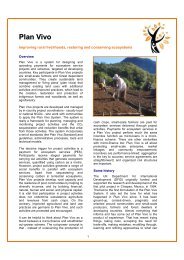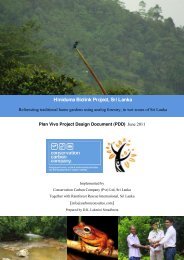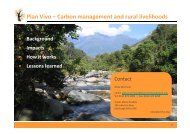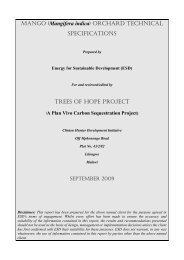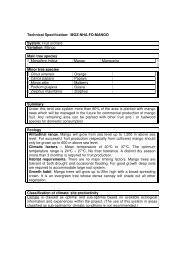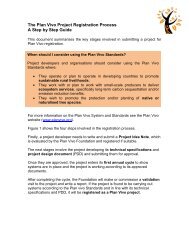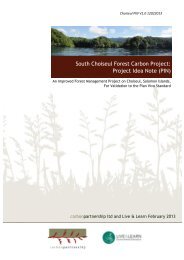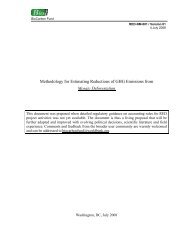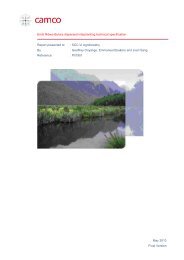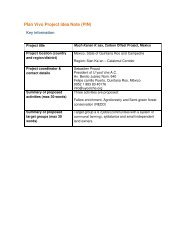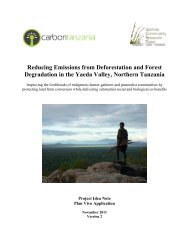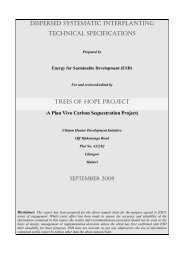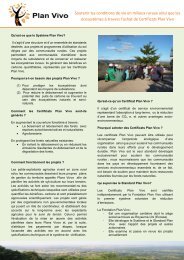Arbres locaux pour un monde meilleur | Local trees for a better world
Arbres locaux pour un monde meilleur | Local trees for a better world
Arbres locaux pour un monde meilleur | Local trees for a better world
Create successful ePaper yourself
Turn your PDF publications into a flip-book with our unique Google optimized e-Paper software.
2<br />
Comm<strong>un</strong>ity Payments <strong>for</strong> Ecosystem Services in Patako | Plan Vivo PDD 2012<br />
by empowering local subsistence farmers and by generating finance from the sale of carbon<br />
credits. The methods <strong>for</strong> quantifying carbon stocks and carbon benefits and generating Plan Vivo<br />
Certificates were developed using an af<strong>for</strong>estation and agro<strong>for</strong>estry Plan Vivo technical<br />
specification developed by Arlomom. Project activities <strong>un</strong>dertaken in the project area include:<br />
af<strong>for</strong>estation/re<strong>for</strong>estation, agro<strong>for</strong>estry, and assisted natural regeneration.<br />
This project has a crediting period of thirty years and a payment period of ten years. F<strong>un</strong>ding has<br />
been secured <strong>for</strong> the first year of activities and the first tranche of PES incentives to participants.<br />
Certificates will be issued ex-‐ante, after annual reporting to the Plan Vivo Fo<strong>un</strong>dation. After each<br />
successful monitoring period, payments will be made to participants. The certifiable carbon<br />
benefits from each activity are as follows: intercropping 28 tCO2/ha, bo<strong>un</strong>dary planting 32<br />
tCO2/ha, plantation 296 tCO2/ha, assisted natural regeneration 296 tCO2/ha.<br />
3 Aims and objectives<br />
The overall aim of the project is to combat desertification and land degradation by improving the<br />
livelihoods of rural comm<strong>un</strong>ities in West Africa and their capacity to generate ecosystem services.<br />
The core objective of the Arlomom Patako project is to restore de<strong>for</strong>ested and highly degraded<br />
land in the Patako landscape by empowering subsistence farmers to adopt sustainable<br />
agro<strong>for</strong>estry and <strong>for</strong>estry practices using native tree species.<br />
The following specific objectives will contribute to the overall aims and the core objective:<br />
1. Reduce resource and income poverty and increase social resilience in the face of climate<br />
change through participation in organised resource conservation activities that support<br />
livelihoods<br />
2. Improve ecological sustainability and food security through more diverse and drought, pest<br />
and disease-‐resilient agro-‐ecosystems<br />
3. Improve economic sustainability and reduce exposure to fluctuations in the prices of crops<br />
and fruits through greater product diversity<br />
Tree planting and management will help to reduce poverty by; strengthening the local economy,<br />
reducing land degradation and promoting biodiversity. Payments <strong>for</strong> Ecosystem Services (PES) will<br />
provide local farmers with an additional revenue stream that will supplement income from<br />
af<strong>for</strong>estation and agro<strong>for</strong>estry activities as well as traditional agriculture (e.g. gro<strong>un</strong>dnuts, millet,<br />
and sorghum).




